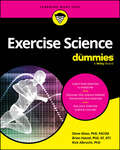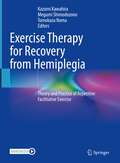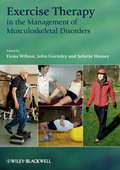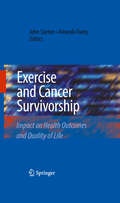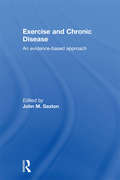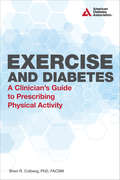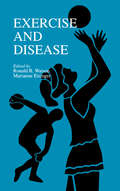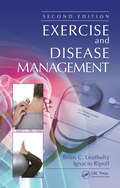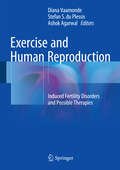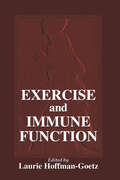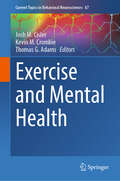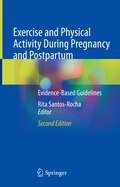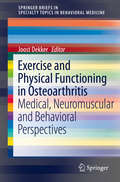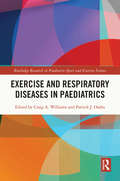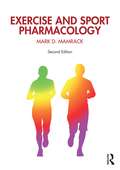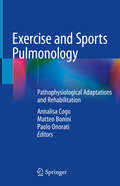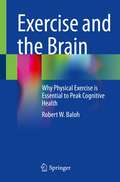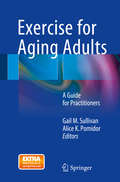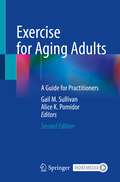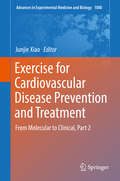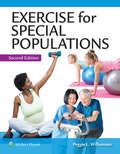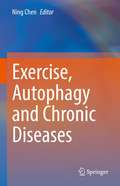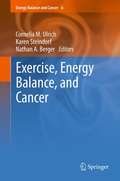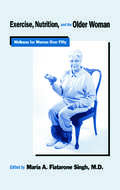- Table View
- List View
Exercise Science For Dummies
by Steve Glass Brian Hatzel Rick AlbrechtA comprehensive guide to the science of movement Exercise Science For Dummies covers must-know information about the how and why to body movement. This useful primer covers content found in a typical introduction course in this topic area—which includes the likes of exercise physiology, biomechanics, and more. With current and helpful guidance, this book includes information on wearable technology, fitness programming across the lifespan, exercise as medicine, and the 101 on human performance, including prevention and care of injuries. With Exercise Science For Dummies, you'll: Discover the science behind movement and exercise Know the powerful connection between the mind and body Understand exercise as a form of medicine Explore fitness across the lifespan Exercise Science For Dummies is a great guide for kinesiology and exercise science majors, coaches and personal trainers, athletes, and anyone who would like to know more about movement.
Exercise Testing and Interpretation
by Christopher B. Cooper Thomas W. StorerThis handbook provides a practical and systematic approach to the acquisition, interpretation, and reporting of physiologic responses to exercise. Pulmonologists, cardiologists, and sports physicians, as well as respiratory therapists and other allied health professionals will find this book an indispensable resource when learning to select proper instruments, identify the most appropriate test protocols, and integrate and interpret physiologic response variables. The final chapter presents clinical cases to illuminate useful strategies for exercise testing and interpretation. Useful appendices offer laboratory forms, algorithms and calculations, as well as answers to FAQs. A glossary of terms, symbols, and definitions is also included. Handbook of Exercise Testing and Interpretation: A Practical Approach offers clearly defined responses (both normal and abnormal) to over thirty performance variables including aerobic, cardiovascular, ventilatory, and gas-exchange variables. Practical, portable, and easy-to-read, this essential guidebook can be used on its own or together with a more detailed book on the subject.
Exercise Therapy for Recovery from Hemiplegia: Theory and Practice of Repetitive Facilitative Exercise
by Kazumi Kawahira Megumi Shimodozono Tomokazu NomaThis book introduces an innovative, efficient, and patient-friendly neural net constructive therapy for patients with mild to severe hemiplegia, not only in the recovery phase but also in acute and chronic phases. The explanations are supported by extensive photographs of each position and a set of 72 video clips to help readers follow and reproduce the techniques. This book explains the theory of Repetitive Facilitative Exercise (RFE), which is a combination of repetitive volitional flexion and extension movements from neurofacilitation approaches. This exercise is aimed at achieving the intended movements and lessening synergistic movement patterns by reconstructing and strengthening the neuropathways of the injured nerve tract. Instead of interpreting disorders based on reflex theory and constructing treatment methods, the new approach considers scientific treatment methods that emphasize the formation of neural pathways by improving synapse formation and transmission efficiency based on functional localization, central programs, and neural nets. Chapters provide a basic theory of RFE, offering the underlying mechanisms of nerve tract formation/strengthening, such as functional localization, voluntary movement, plasticity, and neural lateral sprouting, giving readers a comprehensive understanding of the prompt and repetitive therapy. This is followed by an exposition of practice and techniques, planning of treatment programs, and facilitation techniques for voluntary movements of the upper limb, individual fingers, and lower limb. Finally, the book introduces RFE to facilitate and enhance motor skills in walking and other functions. Exercise Therapy for Recovery from Hemiplegia - Theory and Practice of Repetitive Facilitative Exercise will provide rehabilitation therapists, physiotherapists, occupational therapists, and medical doctors a refreshing alternative theory and practice to current approaches. Neuroscience researchers, stroke patients, and their families would find this book informative.
Exercise Therapy in the Management of Musculoskeletal Disorders
by John Gormley Juliette Hussey Fiona Wilson-O'TooleExercise Therapy in the Management of Musculoskeletal Disorders covers the fundamentals of using exercise as a treatment modality across a broad range of pathologies including osteoarthritis, inflammatory arthropathies and osteoporosis. As well as offering a comprehensive overview of the role of exercise therapy, the book evaluates the evidence and puts it to work with practical ideas for the management of musculoskeletal disorders in different areas of the body, for differing pathologies and for a range of patients. Part 1 introduces the reader tothe role of exercise in managing musculoskeletal disorders and covers measurement and assessment. Part 2 looks at the regional application of exercise therapy with chapters on areas of the body such as the cervical spine, the shoulder complex and the knee. Part 3 examines specific populations: the developing child, the cardiac and respiratory patient, obesity and osteoporosis. Exercise Therapy in the Management of Musculoskeletal Disorders is an invaluable resource for student physiotherapists as well as clinicians designing rehabilitation programmes for their patients. KEY FEATURES Concise and comprehensive Team of expert contributors Offers practical guidance Evaluates the evidence
Exercise and Cancer Survivorship
by John Saxton Amanda DaleyAn increasing number of exercise scientists are applying their skills collaboratively (with medics and physiotherapists) to clinical populations and investigating the effects of exercise in relation to wide-ranging clinical, pathophysiological and psycho-social outcomes. The book is aimed at final year Undergraduate and Master's level students of Exercise Science, who are interested in working with clinical populations such as cancer patients. Many university Sport and Exercise Science courses in the UK and USA now have modules which are focused on exercise for health, and cover aspects of exercise science which are appropriate for clinical populations. The book would also be a very valuable resource for Undergraduate and Postgraduate Physiotherapy courses and a very useful resource for students of Exercise Science and Physiotherapy, as well as practitioners working with cancer patients.There are an increasing amount of research opportunities for exercise scientists who are interested in working with clinical populations. Furthermore, a considerable amount of Government and Charity research funding is being targeted at active lifestyles and this is helping to generate a new culture of collaboration between exercise scientists and medics. Hence, it is highly likely that an increasing number of students from Sport and Exercise Science courses will pursue careers within the clinical realm in the future. Practicing exercise therapists, clinical exercise physiologists and physiotherapists would also find lots of useful up-to-date knowledge to support their evidence-based clinical practice. This book would also be of interest to informed readers who are themselves undergoing or recovering from cancer treatment.
Exercise and Chronic Disease: An Evidence-Based Approach
by John M. SaxtonIt is now widely accepted that there are important links between inactivity and lifestyle-related chronic diseases, and that exercise can bring tangible therapeutic benefits to people with long-term chronic conditions. Exercise and Chronic Disease: An Evidence-Based Approach offers the most up-to-date survey currently available of the scientific and clinical evidence underlying the effects of exercise in relation to functional outcomes, disease-specific health-related outcomes and quality of life in patients with chronic disease conditions. Drawing on data from randomized controlled trials and observational evidence, and written by a team of leading international researchers and medical and health practitioners, the book explores the evidence across a wide range of chronic diseases, including: cancer heart disease stroke diabetes parkinson's disease multiple sclerosis asthma. Each chapter addresses the frequency, intensity, duration and modality of exercise that might be employed as an intervention for each condition and, importantly, assesses the impact of exercise interventions in relation to outcomes that reflect tangible benefits to patients. No other book on this subject places the patient and the evidence directly at the heart of the study, and therefore this book will be essential reading for all exercise scientists, health scientists and medical professionals looking to develop their knowledge and professional practice.
Exercise and Diabetes
by Sheri R. ColbergPhysical movement has a positive effect on physical fitness, morbidity, and mortality in individuals with diabetes. Although exercise has long been considered a cornerstone of diabetes management, many health care providers fail to prescribe it. In addition, many fitness professionals may be unaware of the complexities of including physical activity in the management of diabetes. Giving patients or clients a full exercise prescription that take other chronic conditions commonly accompanying diabetes into account may be too time-consuming for or beyond the expertise of many health care and fitness professionals.The purpose of this book is to cover the recommended types and quantities of physical activities that can and should be undertaken by all individuals with any type of diabetes, along with precautions related to medication use and diabetes-related health complications. Medications used to control diabetes should augment lifestyle improvements like increased daily physical activity rather than replace them.Up until now, professional books with exercise information and prescriptions were not timely or interactive enough to easily provide busy professionals with access to the latest recommendations for each unique patient. However, simply instructing patients to "exercise more" is frequently not motivating or informative enough to get them regularly or safely active. This book is changing all that with its up-to-date and easy-to-prescribe exercise and physical activity recommendations and relevant case studies.Read and learn to quickly prescribe effective and appropriate exercise to everyone.
Exercise and Disease
by Marianne EisingerExercise and Disease reviews the role of exercise and physical fitness in the prevention or causation of cancer. Relevant mechanistic studies, particularly immunomodulation, are emphasized. The book also interprets effects of long-term exercise on immune functions and data that shows how exercise influences disease resistance. On the other hand, exercise may be involved in immune mediated motion injuries. Finally, exercise plays a potential role in cancer therapy. The book will be useful to researchers interested in the most recent developments and their interpretations.
Exercise and Disease Management
by Brian C. Leutholtz Ignacio RipollExercise and Disease Management is designed to help managed care physicians, their patients, other health care professionals, and interested readers integrate current exercise guidelines into their practices. This extraordinary book is accompanied by a series of 11 workbooks, each one for a chronic disease, designed specifically for physicians to give to their patients. These workbooks make it convenient for physicians to prescribe physical activity to their patients in a ready-to-use format. Each book chapter and workbook contains a section on the background, medical management, and exercise guidelines, accompanied by self-care instructions for patients, encouraging them to take a proactive role in their health and disease management. New and Updated in the Second Edition: A ready-to-use "Exercise Prescription Page," which follows each chapter on a specific disease, enables health care professionals, especially physicians in managed care, to prescribe exercise quickly to clients with specific medical conditions The "Rate Pressure Product" method for prescribing exercise helps health care providers individualize exercise prescriptions for patients with heart disease by accounting for the amount of oxygen the heart uses Individual companion workbooks on the downloadable resources provide patient health maintenance information about diabetes, AIDS, obesity, golden years (age 65 and older), heart, kidney, peripheral arterial, and lung disease. Workbooks for physical inactivity, osteoporosis, arthritis and high blood pressure also are included on the downloadable resources Common question-and-answer sections that help patients understand the diseases from which they suffer and encourages them to take responsibility for their health Exercise and Disease Management, Second Edition consolidates the current knowledge base on exercise and chronic disease, providing a ready-made format for health care providers to use when prescribing exercise programs for their clients. Using guidelines set forth by the American College of Sports Medicine and the American Association of Cardiovascular and Pulmonary Rehabilitation, this book helps physicians, other health care providers, and health enthusiasts respond to the challenge to keep patients healthier and active and reduce recurrent hospitalizations and health care costs.
Exercise and Human Reproduction
by Ashok Agarwal Diana Vaamonde Stefan S du PlessisProviding a comprehensive review of the interactions between exercise and human reproduction, this unique text focuses on both the positive and negative consequences of sport and physical activity on male and female fertility and infertility and the biological mechanisms and processes behind them. Beginning with a review of the structure and function of the male and female reproductive systems as well as fertilization and gestation, the discussion then turns to the physiology and endocrinology of sport and exercise, which is further elaborated in subsequent chapters on the impact of physical activity, hormonal changes, pathologies, and consequences of drug use for active men and women. Additional chapters address related topics, such as the impact of sport on young athletes and developing reproductive potential, physical activity and pregnancy, the use of oral contraceptives in athletes, oxidative stress, and the impact of nutritional deficiencies on athletes' fertility, with a final chapter providing recommendations and therapeutic guidelines for exercise-related reproductive disorders. Covering everything from the fundamental principles of sports physiology and human reproductive potential to the interaction between physical exercise and the endocrinology of the reproductive system, Exercise and Human Reproduction is an authoritative resource for helping clinicians understand how the reproductive system adapts to activity and exercise and offers strategies to avoid potential harm to human reproduction.
Exercise and Immune Function (Nutrition in Exercise & Sport)
by Laurie Hoffman-GoetzIn Exercise And Immune Function, leading experts discuss what is known about physical activity and its effects on the immune system. This unique reference describes the science and application of exercise immunology, providing an excellent source of expert information for researchers, students, and practitioners. The impact of exercise on immune function in dieters, in combination with alcohol use, and in the elderly are addressed, and up-to-date reviews on the relationships between exercise and the risk of disease are provided. Anyone in basic medical science, sports medicine, exercise physiology, immunology, and health promotion should have a copy of this book.
Exercise and Mental Health (Current Topics in Behavioral Neurosciences #67)
by Josh M. Cisler Kevin M. Crombie Thomas G. AdamsThis edited volume describes key domains of the emerging research literature linking exercise and mental health. The volume is divided into three sections. The first section provides an overview of foundational knowledge regarding basic processes of exercise, including neurocircuitry, neurotransmitter, and immunology systems. The second section describes emerging research on the acute impact of exercise on affect, mood, and cognition. The third section explores the role of exercise in the etiology and treatment of related mental and physical health disorders, including depression, PTSD, eating disorders, and autoimmune disorders. Collectively, this volume provides readers with foundational knowledge of what exercise is, the basic brain, behavioral and cognitive processes engaged by exercise, and a role of exercise in developing and treating mental health disorders.
Exercise and Physical Activity During Pregnancy and Postpartum: Evidence-Based Guidelines
by Rita Santos-RochaThis is the second edition of a well-received, practice oriented, multidisciplinary book filling the gap between evidence-based knowledge on the benefits of physical activity and exercise during pregnancy and postpartum and the implementation of exercise programs and related health promotion measures in pregnant women.Readers will find up-to-date evidence on the psychological, social, physiological, body composition, musculoskeletal, and biomechanical changes that occur during pregnancy and their implications for physical activity and exercise. Further, the authors equip the reader with the latest guidelines and detailed description of exercise testing, prescription, selection and adaptation for pregnant and postpartum women, including those with clinical conditions.This new edition has been thoroughly updated, and includes additional chapters focused on the pedagogical intervention in pre and postnatal exercise programs, exercise prescription and adaptation during postpartum and diet recommendations for the pregnant exerciser and athlete. Written by recognized experts in the field, the book aims to allay undue fears regarding the consequences of exercising during pregnancy. Moreover, it provides medical, sports, and fitness professionals both with the knowledge and the practical expertise needed to offer an optimal guidance on exercising to pregnant exercisers and athletes.
Exercise and Physical Functioning in Osteoarthritis
by Joost DekkerOsteoarthritis (OA) is among the top 10 of most disabling diseases in the Western world. It is the major cause of pain and disability among the elderly. This book provides a contextual review of recent research on neuromuscular factors and behavioral risk factors for functional decline in OA, with a special emphasis on explanatory mechanisms. In addition, the book discusses innovative approaches to exercise and physical activity in OA, derived from research on behavioral and neuromuscular risk factors for functional decline in OA. Recent research has shown that neuromuscular factors (such as muscle strength, joint laxity) and behavioral factors (such as avoidance of activity, depressed mood) predict pain and disability in OA. Furthermore, exercise and physical activity are among the dominant interventions aiming at reducing pain and disability, and innovative interventions targeting neuromuscular and behavioral interventions have been recently developed. This research has been published as separate papers, with the result that the field is in need of an integrative contextual review that puts the research into theoretical perspective. TARGETED MARKET SEGMENTS Rehabilitation specialists, health psychologists, gerontologists, rheumatologists, pain specialists
Exercise and Respiratory Diseases in Paediatrics (Routledge Research in Paediatric Sport and Exercise Science)
by Craig A. WilliamsIt is commonly accepted that "exercise is good for children" but, considering the number of children worldwide exercising, we know comparatively little, compared to adults, about how specific mechanisms influence health and sports performance. There are considerable obstacles that challenge the progress of paediatric research, not least in relation to ethical and methodological considerations. Therefore, advances in the science and clinical application of paediatric exercise physiology, psychology and biomechanics have not reached their potential. Paediatric clinical exercise physiology has application to the role of exercise in the assessment and treatment of paediatric chronic diseases, the utilization of physical activity in preventing illness and enhancing wellbeing and can enhance our understanding of how sports can be made safer and more enjoyable for our young athletes. Exercise and Respiratory Diseases in Paediatrics highlights research by various methodologies, including literature reviews, experimental research and innovations, applied to children and adolescents with respiratory diseases. Chronic conditions such as asthma, bronchiectasis (e.g., cystic fibrosis), and those associated with prematurity and medical complexity are worldwide health problems for young people and although management includes pharmaceutical medications, physiotherapy, nutritional and psychological support, exercise has a role in optimising multidisciplinary care. There has been unprecedented acceleration in new technologies and methodologies that promise to facilitate paediatric research and these are explained and discussed as future research directions. This is reading for post graduate students, researchers, academics and policy makers within the field of paediatric healthcare, physical activity, physiology and the related disciplines.
Exercise and Sport Pharmacology
by Mark D. MamrackExercise and Sport Pharmacology is an essential book for teaching upper-level undergraduates or entry-level graduate students about how drugs can affect exercise and how exercise can affect the action of drugs. It leads students through the related pathology, exercise physiology, and drug action of many of today's chronically used medications, and discusses how drugs can affect exercise performance. This new second edition of the book is divided into four parts: Section I provides the basics of pharmacology, exercise physiology, autonomic pharmacology, and the stress response; Section II presents chapters on major cardiovascular and respiratory drug classes; Section III describes frequently prescribed medications for such common conditions as diabetes, depression, pain, fever, inflammation, and obesity; and Section IV includes discussions of nutritional supplements and commonly used drugs such as caffeine, nicotine, cannabis, and performance-enhancing drugs. The second edition offers many updates, enhances muscle cell physiology, includes the involvement of the gut microbiome, and each chapter has a new section on the effects of aging. In Sections II and III, chapters include an overview of the pathology that therapeutic drugs are designed to treat and how the drug works in the human body. In contrast to standard pharmacology texts, Exercise and Sport Pharmacology also includes the effect of exercise on the pathology of the condition and the effect of exercise on how the body responds to a drug. Each chapter has a section on whether the drugs under discussion have performance-enhancing potential. Section IV is concerned with self-medication and drugs or supplements taken without a prescription or with limited medical supervision. Throughout, figures and tables as well as data from experiments in exercise pharmacology help to illustrate and summarize content. Each chapter opens with an on-going case example to preview and apply chapter content. In the text, boldface terms indicate which concepts are contained in the book's Glossary. Chapters conclude with a Key Concepts Review and Review Questions.
Exercise and Sports Pulmonology: Pathophysiological Adaptations and Rehabilitation
by Annalisa Cogo Matteo Bonini Paolo OnoratiThis book provides an innovative and comprehensive overview of the relationship between lung and exercise, both in healthy, active subjects and in subjects with chronic respiratory diseases. It investigates in detail the central role of the lungs during exercise and illustrates the impact of respiratory impairment due to both acute and chronic lung diseases on performance. Further, the book presents the latest evidence-based findings, which confirm that exercise is an effective and safe form of prevention and rehabilitation in respiratory diseases.The first section describes the changes in the respiratory system during exercise and the contribution of respiration to exercise, while readers will learn how to perform a respiratory assessment in the second section. The third section addresses a broad range of chronic respiratory diseases and the (in)ability of those affected to play sports and perform exercise, thus providing a basis for individual assessments. The last two sections focus on respiratory training, rehabilitation and the relationship between respiration and the environment, e.g. in high-altitude and underwater sports. The book will appeal to a wide readership, including pulmonologists, sport medicine physicians, physiotherapists and trainers, as well as instructors and students in exercise science.
Exercise and the Brain: Why Physical Exercise is Essential to Peak Cognitive Health
by Robert W. BalohThis book focuses on the benefits of exercise for prevention and treatment of chronic brain disorders. It is a guide for finding the right exercise routine for each individual. The goal is to show the reader why everyone needs to exercise, especially as we get older. The brain needs physical exercise both for normal health and for preventing and treating diseases common with aging.How much exercise is needed? As we see throughout the book there is no one fits all rule with regard to the amount of exercise required. The key is to make exercise a part of one’s daily routine. The beneficial effect of exercise is transient, lasting days to weeks, so it must be a lifelong pursuit. Can we exercise too much? Anything done in excess can potentially be dangerous but with the common sense approach outlined in this book anyone, regardless of underlying health condition, can find some type of exercise that is safe and effective.
Exercise for Aging Adults
by Gail M. Sullivan Alice K. PomidorThis book translates the new findings in exercise research for the elderly for busy practitioners, trainees, students and administrators. This book provides practical strategies that can be implemented immediately in the common settings in which practitioners care for adults. The format includes key points and case examples which showcase the strong evidence supporting exercise by older adults as a key tool to enhance health, prevent serious outcomes, such as hospitalization and functional loss, and as part of the treatment plan for diseases that are common in older adults. Written by experts in the field of exercise in older persons, this book is a guide to maintaining quality of life and functional independence from frail to healthy aging adults. Strategies and exercises are discussed for specific care settings and illustrated via links to video examples, to ensure readers can immediately apply described techniques. Exercise for Aging Adults: A Guide for Practitioners is a useful tool for physicians, residents in training, medical students, physical therapists, gerontology advance practice nurse practitioners, assisted living facility administrators, directors of recreation, and long-term care directors.
Exercise for Aging Adults: A Guide for Practitioners
by Gail M. Sullivan Alice K. PomidorExercise has been rightly termed the “fountain of youth” for older adults. Exercise is associated with lower risks of developing many chronic conditions (cardiac disease, diabetes mellitus, osteoporosis) as well as being a key treatment modality for common geriatric problems (osteoarthritis, falls, incontinence, sleep issues, frailty). Exercise, or regularly planned physical activity, is also associated with higher functional levels and well-being, which many older adults consider critical for a high quality of life. Indeed, many physiologic changes formerly attributed to senescence appear due to disuse and thus less inevitable than assumed. The dictum of “use it or lose it” holds true, for people 70 years and older. This user-friendly text provides practical strategies for health care professionals who work with or advise older adults to create exercise prescriptions suitable for specific settings and medical conditions. Expanded and revised,the second edition translates new findings in exercise research for the elderly for busy practitioners, trainees, students and administrators and provides practical strategies that can be implemented immediately in the common settings in which practitioners care for adults. It includes key points and case examples which showcase the strong evidence supporting exercise by older adults as a key to enhance health, prevent serious outcomes, such as hospitalization and functional loss, and as part of the treatment plan for diseases that are common in older adults. Strategies and exercises are discussed for specific care settings and illustrated via video examples to ensure readers can immediately apply described techniques.Written by experts in the field, Exercise for Aging Adults is a valuable guide to maintaining quality of life and functional independence from frail to healthy aging adults for physicians, residents in training, medical students, physical therapists, gerontology advance practice nurse practitioners, assisted living facility administrators, directors of recreation, and long-term care directors.
Exercise for Cardiovascular Disease Prevention and Treatment
by Junjie XiaoThe book provides an intensive overview on exercise for cardiovascular disease prevention and treatment, from basic research to clinical practice. The volume firstly summarizes the acute and chronic response to exercise. Secondly, evidence for exercise as medicine for the heart based on clinical studies and basic research is summarized. Thirdly, molecular mechanisms mediating the beneficial effects of exercise including IGF-1-PI3K-AKT signalling, NO signalling, C/EBPB-Cited4 signalling, Non-coding RNAs, epigenetic regulators, mitochondria adaption and exosomes are presented. Finally, exercise dosing, prescription and future prospects are provided. This book will provide valuable reference for researchers in cell biology, physiology, as well as physician, physical therapist in cardiology, sport medicine, etc.
Exercise for Special Populations
by Peggie WilliamsonPublisher's Note: Products purchased from 3rd Party sellers are not guaranteed by the Publisher for quality, authenticity, or access to any online entitlements included with the product. This updated 2nd Edition of Williamson’s highly applied Exercise for Special Populations provides just enough background for practicing and future personal trainers, exercise physiologists, and other health and fitness professionals to develop and implement exercise programs for special populations. For each condition, the book provides a general description, anatomy and physiology variances, precautions, recommendations for exercise testing and prescription, instructions and images of various exercises, and nutritional considerations. Reflecting the latest best practices in the field, the 2nd Edition features new chapters and pedagogy and a powerful suite of online resources.
Exercise, Autophagy and Chronic Diseases
by Ning ChenThis book establishes a bridge between exercise-mediated functional status of autophagy and non-communicable chronic diseases for elucidating and clarifying the corresponding signal pathways and underlying mechanisms. The book consists of 13 chapters focusing on the in-depth discussion on signal pathways for regulating the functional status of autophagy for the prevention, treatment and rehabilitation of chronic diseases, the optimization of exercise intervention strategies for common and frequently-occurring chronic diseases, and the development of exercise mimetic pills for the persons with disability for exercise performance, or the persons without willing to exercise. This book is interesting and will be useful to a wide readership in the various fields of exercise science, exercise fitness, sports medicine, preventive medicine, and functional foods.
Exercise, Energy Balance, and Cancer
by Nathan A. Berger Cornelia M. Ulrich Karen SteindorfWhile it is well established that the worldwide pandemic of overweight and obesity has profound effects on promoting cancer, it is now recognized that an alternative aspect of energy balance, namely physical activity and exercise have significant beneficial effects on all aspects of cancer across the spectrum from prevention through treatment and extending through survivorship. Moreover, salutary effects of physical activity and exercise extend across the age span from youth to old age and occur at all stages of cancer extending into palliative care. While the effect of physical activity and exercise on cancer may be partially mediated through obesity control, it is clear that considerable research is required and is ongoing at both the molecular and clinical levels to better understand the associated mechanisms and to develop optimal exercise strategies. This volume will contain chapters on the effect of exercise on biological pathways in tumor growth, state art exercise strategies and cutting edge research focused on different cancers and patient groups. It will provide an important volume in this series on energy balance and cancer and a basis for ongoing research, experimental approaches and application of evidence based practices to clinical care for patients with cancer.
Exercise, Nutrition and the Older Woman: Wellness for Women Over Fifty
by Maria A. Fiatarone SinghExercise, Nutrition and the Older Woman: Wellness for Women Over Fifty is a comprehensive guide to the major wellness issues for women over fifty. The author is a physician who explores diet, exercise and lifestyle choices from a medical perspective. The book assists in the design and implementation of programs to optimize good health and quality o
